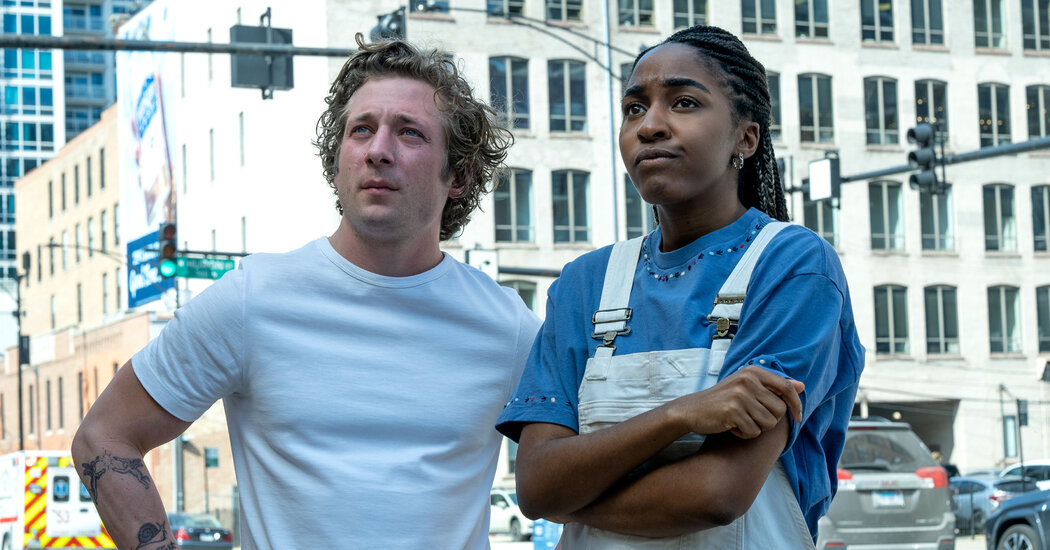The first time I heard a stranger say “corner” outside a kitchen, I was taken by surprise, but pretty soon, I lost count. After the FX show “The Bear” began streaming on Hulu in 2022, shouting out phrases that bounce around professional kitchens became something of a national bit.
In Bon Appétit, Sarah York coined the term Line Cook Summer to describe the frenzy over Jeremy Allen White’s character, Carmen Berzatto — a soft, dirtbag type. Even before the Calvin Klein underwear ad, it was perfectly captured in a New Yorker cartoon by Emily Flake. In it, a woman — flushed, happy, naked — lies in bed next to her befuddled husband, who asks, “So … what was all that ‘Yes, Chef’ stuff about?”
The show drove affection toward a big-hearted, dysfunctional kitchen crew at an unlikely moment, two years into the pandemic, after so many investigations into abusive chefs and work environments that the word “toxic” had become not just vague, but inadequate.
The third season begins streaming on Thursday, and the trailer already has nine million views on YouTube. At least three of those were me, trying to wrap my mind around the expanse of the “Bear” effect — I’ve been fascinated by chefs onscreen for decades.
The Swedish Chef, his Muppet eyes hidden under caterpillar brows and floppy toque, tickling the shrimp, was a mildly distressing clown. The fussy, elegant Italian brothers in “Big Night,” played by Stanley Tucci and Tony Shalhoub, blurred the dysfunction of a restaurant “family” with their own. Courteney Cox as Monica Geller, the underappreciated perfectionist of “Friends,” cooked her way through the most complex feelings a ’90s sitcom would allow. And Martina Gedeck only seemed impenetrable as the second-best chef in Hamburg in the 2001 German movie “Mostly Martha.”
Jon Favreau was charming in “Chef,” and Bradley Cooper overplayed it in “Burnt,” though something about both those chefs struck me as faintly embarrassing. Most recently, Ralph Fiennes played the part as a cartoonish psychopath in “The Menu.” And speaking of cartoons, animation has delivered some of our most delicious performances, including Bob from “Bob’s Burgers” — a perpetually broke small-town burger chef and a grumpy, but loving dad, hopelessly devoted to his craft.
None of these chefs landed with the sweaty force of Carmy, trying and failing to cook at the highest level without causing any damage. The profoundly unglamorous, relentless kitchen work in the show was widely complimented as “realistic,” as something that might even deepen our understanding of restaurants.
If you were following along, “The Bear” didn’t just get food and cooking right. It got Chicago right, it got the culture of the workplace right, it got the complexity of grief right, it got the devastation of addiction right, it got the beauty of good hospitality right — along with the tortured ache that can lurk behind it.
It also got that the chef wasn’t the only important character in a restaurant, and slowly expanded its story lines into the emotional lives of the other people prepping, washing dishes, scrubbing walk-ins and fixing toilets through dysfunction and disaster.
Restaurants featured on the show — even for a few moments — experienced a surge in business. Italian beef sales boomed. A cottage industry of gastro tourism bloomed in Chicago, where you can hop a bus and take a tour inspired by the show (led by someone dressed as Carmy).
But so much of the pleasure of watching “The Bear” has been in the investigative work that followed each episode — where exactly were the characters eating, what were they wearing, how were they cooking? We needed to know.
To meet our collective appetite for the characters’ stuff, users on Reddit and TikTok, along with editors and writers, identified and analyzed the minutiae of everything that appeared on the show. We could cook with the same San Marzano tomatoes. Replicate the cookbook collection. Wear the exact brand of white T-shirt that hugs Carmy’s biceps. Shop for Sydney’s exquisite scarves. Label our quart containers at home with the same green painter’s tape.
We stripped the kitchen for its parts: lingo, recipes, shoes. There was so much excitement over what was “real,” but little interest in the real, tedious issues restaurants were dealing with.
The effect of the “Bear” effect on us has been an interest, not so much in the people who work in kitchens, but in their aesthetic. In the sweet, shoppable details of the cook’s accessories, from the warped quart container to the vintage jacket.
If “The Bear” attuned us to the realities of working in professional kitchens, primed us for understanding and insight into the restaurant industry’s complexities, the “Bear” effect pulled us away in search of a pair of Birkenstock Tokios. No item has been too small to covet.
Maybe this is just how we watch TV now, but after I finished the second season, I gave in to the impulse to buy a fresh set of Sharpies for my home kitchen.
Before I even had them in my hands, I imagined tearing the crinkly plastic that held them in place away from the cardboard. I imagined the pleasure of writing with a fresh and inky nib. And when I finally uncapped a pen to gratuitously mark a Cambro of flour in my home kitchen, I could almost pretend that the show was bleeding over into my real life.







